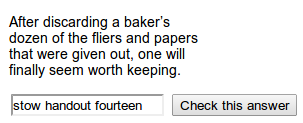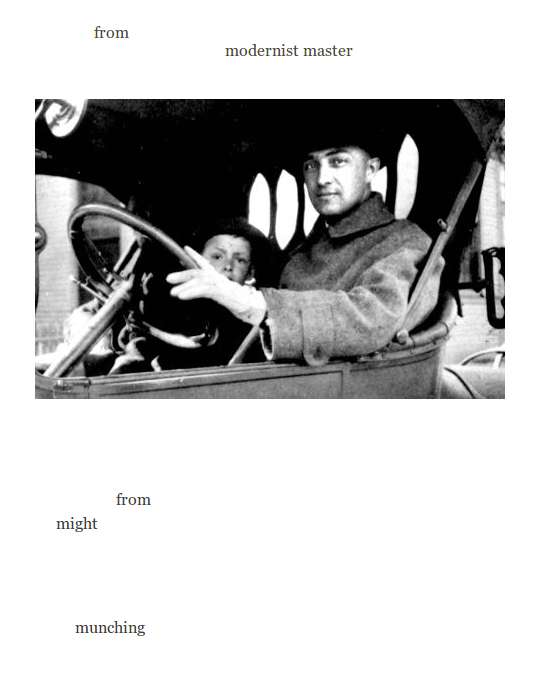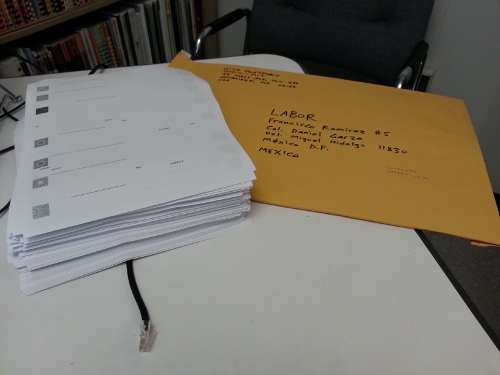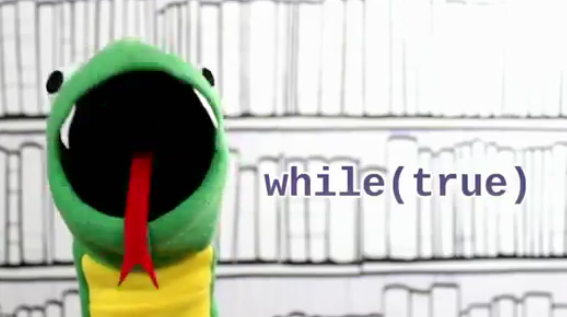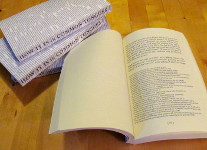You may have noticed that “corpse” and “corporate” are lexically quite similar, and seem even more so when it comes to technology. Slate’s Google Graveyard lets visitors leave a virtual flower in memory of their favorite dead Google product. Seeking to be ever ready, they have dug a hole for Google Glass.
Get Yer Consumer Survey Here
I like clicking through this: “Psychographics: Consumer Survey” by Dane Watkins. And I learned something about myself by doing so. I think. Yes.
“Description,” My 2014 New Year’s Poem
“Description,” my 2014 New Year’s poem, was sent out as a text file at the end of 2013; it’s now online in a solvable and checkable form, in a new Web edition.
10 PRINT in 64 bytes of JavaScript
From p01 comes a 64 byte JavaScript program to produce a random-seeming maze, as long as the person at the computer is willing to wiggle the mouse a bit. It’s on pouet.net, with comments, too.
European Poetry Forum is up
The new project European Poetry Forum by Zuzana Husarova Martin Solotruk is now online.
The project aims to connect a diverse group of poets with overlapping interests, as this statement about it explains. There are answers to queries from 38 poets up now.
Nice Try, But Even This is Better

Remix Redux
Of my “Taroko Gorge”:
“Take Ogre” by John Pat McNamara, remixed Febuary 16, 2013 on Achill Sound, Ireland. The piece trades off the images of the natural world for language of the mind, and sports a nice recursive background. (View source for some further information in a comment up top.) Thanks to publisher Michael J. Maguire for noting this remix in a comment here.
“TransmoGrify” by Leonardo Flores of I ♥ E-Poetry, published in Springgun Press Journal, issue number 8. (There’s a note on the piece in the journal.) This one is also about contemplation and mental work, endlessly describing the process of remixing “Taroko Gorge.”
In a different way, “TransmoGrify” is as meta as the remix “Argot Ogre, OK!” by Andrew Plotkin, whose titular monster also returns in John Pat McNamara’s work. Take my ogre — please! Take my gorge…
Round and Duels — Duets Published
I have two new digital pieces (one a collaboration) that have just been published by James O’Sullivan’s New Binary Press:
Round is a computational poem that is non-interactive, deterministic, and infinite (boundless), since it simply substitutes text fragments for the digits 0-9 and presents a representation of the digits of pi. See the note for further information, and if the concept intrigues you at all, please, run the piece for a while.
Duels — Duets, by Stephanie Strickland and Nick Montfort, was developed after Stephanie suggested we write something about collaboration based on our experience developing Sea and Spar Between. We co-created a combinatorial poem based formally on A House of Dust by Alison Knowles and James Tenney, producing about the amount of text that was requested of us for print publication.
New Binary Press has a news item about the publication of these two pieces, too.
How to Read a Page of the Worl
If you visit this page on the Worl, you may wonder how to read it.
Now, if you just click on that link, you’ll be taken to that page on the Web. To get to the Worl page, you’ll need to install The Deletionist bookmarklet and, once you get to the Web page, click on it. If the page is exactly the same as when I viewed it (it may change, as it’s a wiki front page) you can be sure that your Worl page looks the same as mine did — we’re both looking into the same Worl.
So, you may wonder how to read it.
I read it like this:
from modernist master
Here’s one of many amazing pages on, not the World Wide Web, but The Worl: http://www.poetryfoundation.org/learning/guide/236558
(You need to install and activate The Deletionist to see it correctly…)
Hoc Opus, Hic Labor Est
The Internent isn’t just the Web; it’s also telnet, Gopher, email … and the Worl. Here are 500 pages of the Worl that I printed out and mailed today to Kenneth Goldsmith’s exhibit, Printing Out the Internet.
The Worl is accessible to anyone who has a recent Web browser and has installed The Deletionist.
The Deletionist
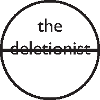 I’m pleased to announce the release of a project that I’ve been working on with Amaranth Borsuk and Jesper Juul for the past two years: The Deletionist. This is a bookmarklet (easily added to the bookmark bar in one’s browser) that automatically creates erasure poetry from any page on the World Wide Web, revealing an alterate mesh of texts called the Worl. Amaranth and I presented The Deletionist for the first time today at E-Poetry in London, at Kingston University.
I’m pleased to announce the release of a project that I’ve been working on with Amaranth Borsuk and Jesper Juul for the past two years: The Deletionist. This is a bookmarklet (easily added to the bookmark bar in one’s browser) that automatically creates erasure poetry from any page on the World Wide Web, revealing an alterate mesh of texts called the Worl. Amaranth and I presented The Deletionist for the first time today at E-Poetry in London, at Kingston University.
House of Leaves of Grass
What miracle is this? This giant tree.
It stands ten thousand feet high
But doesn’t reach the ground. Still it stands.
Its roots must hold the sky.
O
HYMEN! O hymenee!
Why do you tantalize me thus?
O why sting me for a swift moment only?
Why can you not continue? O why do you now cease?
Is it because, if you continued beyond the swift moment, you would soon certainly kill me?
[This “House of Leaves of Grass” is a 24K poetry generator that produces about 100 trillion stanzas. Vast, it contains multitudes; it is bigger on the inside than it is on the outside. By Mark Sample, based on “Sea and Spar Between.”]
For Those of You Reading This with Google Reader
One classic downfall deserves another: Hitler reacting to the cancellation of Google Reader.
Code, Poetry Intersect in a Corner
In this episode of Poetry Corner with Guido, Guido the python shares a Gertrude Stein poem titled Sacred Emily.
Jared Nielsen, thanks to his schooling in Modern and Contemporary American Poetry, his ability as a programmer, and his recent creation of a puppet, has developed an amazing conflation of Gertrude Stein, the Python programming language, and the Wonder Showzen episode “Patience.”
Nielsen has been recreating famous American poems in Python or so that they are about Python, as in “The Red Wheelbarrow” and “Song of Myself.”
His project parallels that of Páll Thayer along two dimensions: Thayer, in his series Microcodes, presents short programs in Perl (not Python) that often recreate famous artworks (not poems), for instance Vito Acconci’s Seedbed and Jasper Johns’s Flag.
We must admit, however, that Thayer does not employ a puppet named after Larry Wall.
Flores on Sea and Spar Between
Leonardo Flores has posted a nice discussion of Sea and Spar Between (by Nick Montfort and Stephanie Strickland) on his blog, I ♥ E-Poetry.
Radical Books of 2012 (2/7)
How It Is in Common Tongues
Cited from the Commons of digitally inscribed writing by John Cayley & Daniel C. Howe
NLLF [Natural Language Liberation Front] · 296 pages
Some seek diamonds in the rough on the Web; others mine from this lode of language mud and darkness. This profound document was fashioned with snippets of pages, with the search engine, and with the novel first publised as Comment c’est – using all of them quite perversely. Samuel Beckett’s 1964 How It Is describes a person moving and not moving through the mud, alone, not alone, and then once more alone. Cayley and Howe, bending the service known as Google to their literary purposes, have located every phrase of the novel on Web pages where no reference to Beckett is made. For instance, the first words, “how it was I quote,” are found in a New York Times excerpt from Elie Wiesel’s And The Sea is Never Full. The phrase is provided, the URL is given in a footnote … and the same is done for every other phrase in How It Is. The result is an edition of Beckett’s book made of text that was literally found on the Web. The only thing funnier will be the Beckett Estate’s response.


